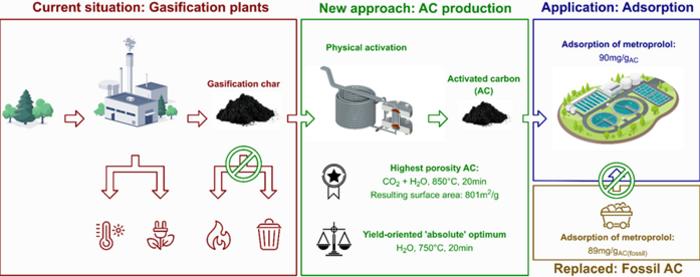Gasification technology is not just a forward-thinking approach in the realm of renewable energy; it serves as a critical component in the wider fight against climate change. By converting wood into combustible gas through high-temperature processes, it allows users to produce fuel or electricity effectively. One of the more surprising by-products of this process is gasification char—a residual solid that remains after the conversion is complete. While often viewed as waste, Austrian researchers are now shedding light on its potential to be upgraded into activated carbon, thereby transforming a nuisance into a valuable resource.
Activated carbon is widely recognized for its ability to adsorb impurities and pollutants, making it invaluable in environmental applications such as water treatment. However, traditional sources of activated carbon include harder materials, like fossil coal, which yield carbon structures that are highly porous and thus suitable for maximizing adsorption capacities. In contrast, gasification char, derived primarily from wood, presents unique challenges due to its softer composition. As its structure is less porous, it traditionally struggles to compete in terms of adsorption capabilities. Yet researchers contend that with the right processes in place, this residual material can indeed become a useful resource.
In an exciting recently published study in the journal Carbon Resources Conversion, a team of researchers from Austria undertook the task of investigating how to transform gasification char into usable activated carbon efficiently. With a focus on physical activation methods, the researchers aimed to use oxidizing gases at elevated temperatures to induce the necessary structural transformations. By creating tiny pores within the char, these gases would allow for enhanced capture of pollutants—a leap toward maximizing its utility.
David Gurtner, the first author of the study and a PhD student at BOKU University, explained that even though achieving high porosity from softer materials like gasification char represents a challenge, it does not preclude the potential for activated carbon manufacture. It opens doors not only to new methodologies but also to a sustainable resource that offers a pathway away from fossil fuel dependence. Highlighting the novelty of this research, Gurtner noted that past studies lacked depth regarding economic evaluations and comprehensive analyses, indicating a significant gap that this present research aimed to fill.
Employing the Design of Experiments statistical tool, the researchers optimized the porosity of the activated carbon produced from gasification char, which led to breakthroughs in the adsorption performance of the material. Their efforts culminated in the creation of activated carbon with an impressive surface area of 800 m²/g. Such a measurement presents an astonishing figure—by way of comparison, a mere teaspoon of this activated carbon aligns with the extensive surface area of an ice hockey rink.
Moreover, preliminary results from the experiments indicated that activation methods involving mild temperatures of 750 °C or lower, combined with water activation over a duration of at least twenty minutes, proved most effective in enhancing the adsorption capacities of the end product. This innovative approach has implications for scaling the technology at commercial gasification facilities, opening avenues not only for sustainability but also for economic viability.
The need for renewable activated carbon is set to burgeon in the coming years. With impending European Union regulations demanding the removal of micropollutants from vast wastewater treatment systems by 2045, and Switzerland already demonstrating large-scale applications of activated carbon in its own treatment facilities since 2016, the time is ripe for a shift towards more sustainable sources of activated carbon. Awareness of this shift is crucial for stakeholders in both energy production and environmental management, as the demand is only expected to rise.
Gurtner and his team expressed hopes that their work would inspire the gasification sector to further pursue this newfound value-added pathway in producing renewable activated carbon. By developing such modalities, we could significantly minimize our reliance on fossil-fuel-sourced activated carbon, contributing positively to global environmental health.
The findings are more than just theoretical musings; they signify a tangible means of capitalizing on waste materials that have long been relegated to the sidelines of energy production discussions. The researchers’ commitment to transforming gasification char into activated carbon not only speaks volumes to innovative uses of by-products but also embodies the essence of sustainable resource management.
As these researchers pave the way toward integrating gasification technologies with activated carbon production, it increasingly appears that the energy landscape is on the cusp of a significant transformation. This coalition has the potential to restructure how we think about waste in bioenergy production and, by extension, our broader environmental ambitions. By putting carbon resources to good use, we can turn the tide against pollution while supporting a burgeoning green economy.
While traditional activated carbon sources have long dominated the market, the ability to derive activated carbon from wood-based gasification char can offer a versatile substitute that is more in alignment with ecological sustainability principles. As the gasification process continues to evolve, so too may our approaches to solving pollution problems, showcasing a promising horizon for both technology and the environmental sector.
In conclusion, the transition to utilizing gasification char for activated carbon production stands to innovate the renewable energy sector’s approach to waste management and pollutant removal. With emerging technologies and methodologies, the foundational impact on environmental safety and health will undoubtedly ripple across industries for years to come.
Subject of Research:
Article Title: Renewable activated carbon from wood-based gasification char: A comprehensive study on physical activation
News Publication Date:
Web References:
References:
Image Credits: Credit: David Gurtner
Keywords: Climate change, Plant sciences, Pollution, Industrial engineering, Hydrology, Water resources




